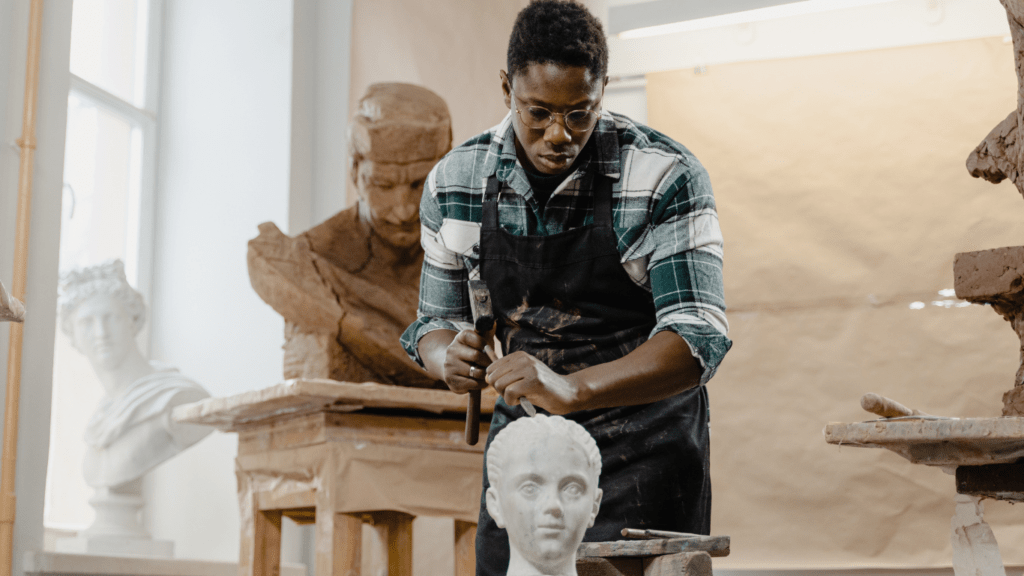Understanding Art Therapy
Art therapy combines creative processes with psychological theories to improve mental health. It’s a type of expressive therapy where art becomes a path to emotional well-being.
The Basics of Art Therapy
Art therapists blend creativity with clinical expertise. They guide clients in utilizing various artistic mediums like:
- drawing
- painting
- sculpture
This process allows individuals to express feelings that may be difficult to verbalize.
Certified art therapists hold degrees in art therapy and counseling. They use detailed assessments to tailor sessions to individual needs. These professionals operate in diverse settings, including hospitals, schools, and private practices.
Benefits of Art Therapy
Art therapy offers multiple benefits across emotional and psychological realms. It reduces stress by providing an outlet for emotions, helping to manage anxiety and depression. In a 2016 study, the American Art Therapy Association noted a 77% improvement in stress-related symptoms among participants.
It enhances self-awareness by enabling individuals to explore their inner experiences visually. This aspect is crucial for trauma survivors who might find verbal expression daunting.
Additionally, art therapy boosts self-esteem. Completing a creative project provides a sense of accomplishment, fostering confidence and a positive self-image.
Creative Techniques in Art Therapy
Art therapy employs various creative techniques to help individuals express emotions and achieve mental clarity. Below are some effective methods used by certified art therapists.
Collage Making
Collage making involves assembling different materials like photos, fabric, and paper onto a single surface. This technique helps clients visualize thoughts and feelings they’ve been unable to articulate. Combining diverse textures and images allows fragmented emotions to emerge, making it easier to discuss complex issues. It’s particularly useful for clients reluctant to verbalize their experiences.
Sculpting with Clay
Sculpting with clay encourages tactile engagement, which can be soothing and grounding. Manipulating clay allows individuals to release tension and frustration while creating tangible representations of their inner state. Through the process, clients discover insights into their subconscious thoughts. Art therapists often use this technique to help clients dealing with trauma or high anxiety.
Painting and Drawing
Painting and drawing are traditional art therapy techniques that facilitate free expression. Clients can choose colors, shapes, and forms to represent their emotions. This process reveals patterns in their thinking and emotional state. Art therapists analyze these patterns to guide conversations, helping clients gain self-awareness and cope with psychological issues.
Digital Art Therapy
Digital art therapy uses technological tools like tablets and software to create art. It’s convenient for clients who prefer digital mediums over traditional ones. Digital platforms offer a limitless variety of artistic tools, enabling intricate and detailed creations. This technique is particularly beneficial for those comfortable with technology, facilitating engagement in the therapeutic process.
Implementing Art Therapy

Implementing art therapy involves tailored techniques applied in various settings to meet individual client needs. I explore crucial aspects to provide a holistic overview.
Settings for Art Therapy
Art therapy takes place in diverse environments. Hospitals use it to support patients with chronic illnesses. Schools integrate it to help children manage stress or behavioral issues.
Rehabilitation centers utilize art therapy to assist with addiction recovery. Community centers offer it to foster social interaction among participants. These varied settings ensure art therapy is accessible to different populations needing emotional support.
Art Therapy in Groups vs. Individual Sessions
Art therapy benefits both group and individual sessions. Group sessions encourage collaboration and social interaction, making them ideal for those seeking communal support.
Participants often feel validated and less isolated when sharing their artwork. In contrast, individual sessions focus on personal challenges and tailored approaches. One-on-one settings allow clients to delve deeper into personal issues, ensuring a personalized therapeutic experience. Ultimately, session type depends on client needs and therapeutic goals.
Case Studies and Success Stories
Art therapy leads to transformative outcomes for many individuals. Below are examples showcasing therapeutic breakthroughs and quantitative improvements.
Examples of Therapeutic Breakthroughs
An 8-year-old child with autism began using clay sculpting in sessions. After 6 weeks, the child showed increased focus and communication skills, expressing emotions previously held back.
In a group setting, veterans with PTSD created paintings to depict their traumas. Over 8 sessions, participants reported reduced flashbacks and enhanced emotional well-being.
A teenager battling depression engaged with digital art therapy. Customized sessions incorporating tablets and styluses led to higher engagement levels and a noticeable lift in mood over 3 months.
Quantitative Improvements from Art Therapy
A study by the American Art Therapy Association found that 75% of participants experienced a significant decrease in anxiety and depression symptoms after 10 art therapy sessions.
| Metric | Improvement Rate |
|---|---|
| Anxiety Reduction | 75% |
| Depression Reduction | 75% |
| Communication Improvement | Significant increase in 8-year-old with autism |
| Emotional Well-being | Enhanced in veterans with PTSD |
In a hospital setting, chronic pain patients engaged in art therapy reported a 60% reduction in perceived pain levels, contributing to better overall patient outcomes.

 Anna Freehill, a key contributor to Avant Garde Artistry Hub, plays a vital role in shaping the platform’s vision. As an author and collaborator, she helps bridge the worlds of art and technology, offering insightful articles that guide artists through the rapidly evolving creative landscape. Anna’s dedication to highlighting art's therapeutic value has contributed to the platform’s focus on mental and emotional well-being through creative expression.
Her involvement in building Avant Garde Artistry Hub has been instrumental in providing valuable resources to artists seeking to enhance their careers. Whether through her writing on business strategies or her support in platform development, Anna is committed to fostering a space where artists can thrive and embrace the future of art.
Anna Freehill, a key contributor to Avant Garde Artistry Hub, plays a vital role in shaping the platform’s vision. As an author and collaborator, she helps bridge the worlds of art and technology, offering insightful articles that guide artists through the rapidly evolving creative landscape. Anna’s dedication to highlighting art's therapeutic value has contributed to the platform’s focus on mental and emotional well-being through creative expression.
Her involvement in building Avant Garde Artistry Hub has been instrumental in providing valuable resources to artists seeking to enhance their careers. Whether through her writing on business strategies or her support in platform development, Anna is committed to fostering a space where artists can thrive and embrace the future of art.